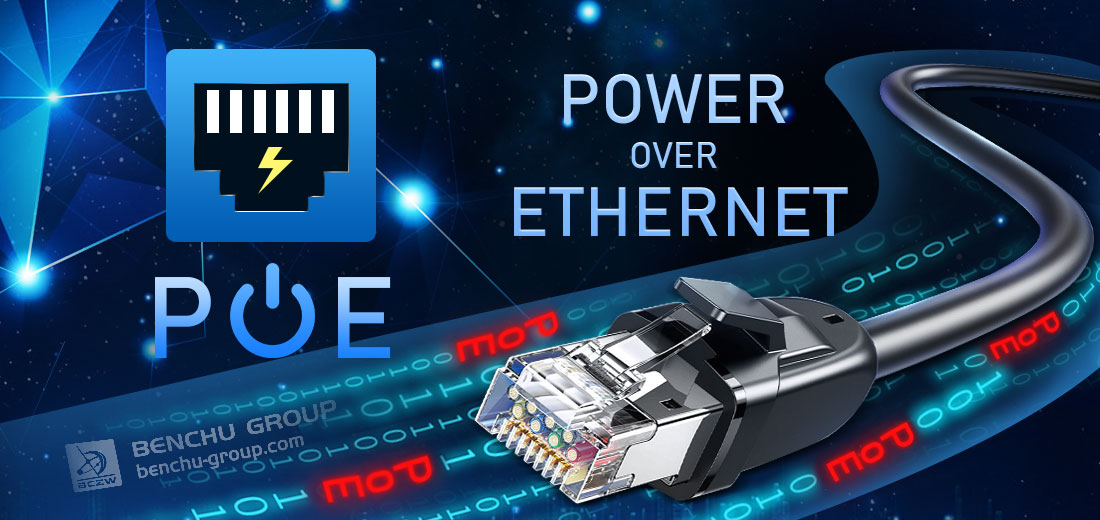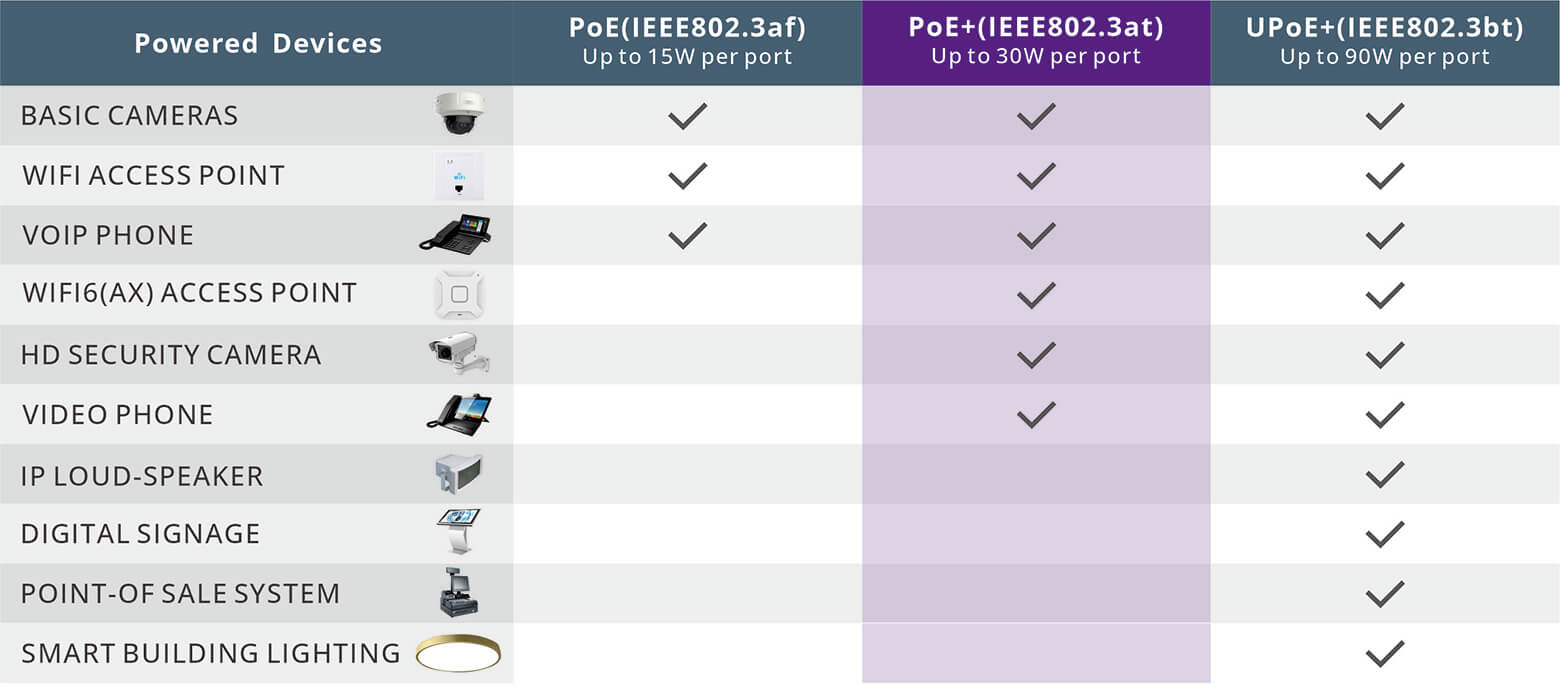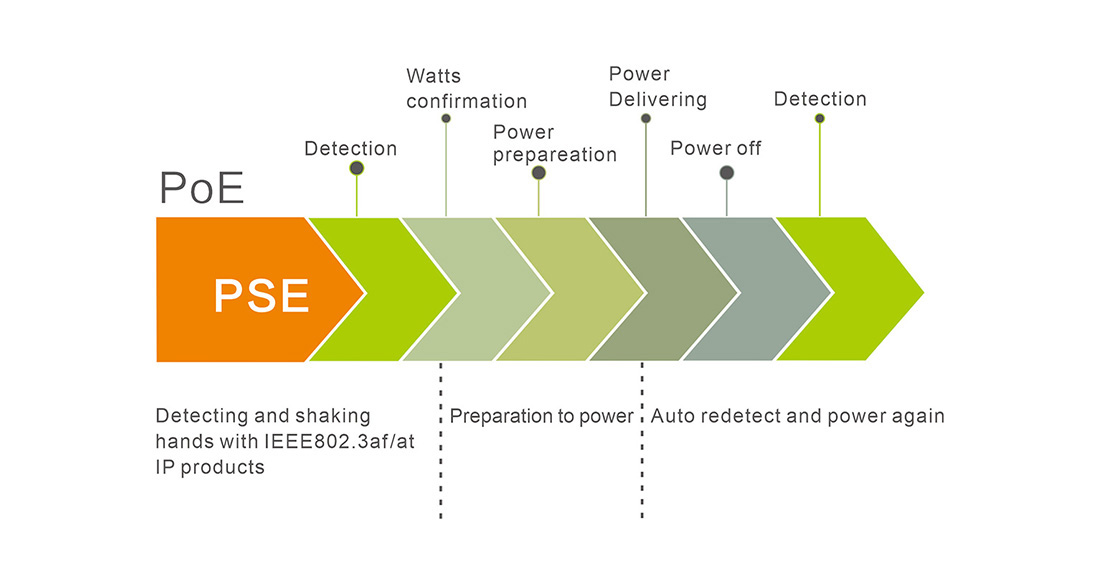
POE (Power Over Ethernet) refers to a technology that, without any modifications to the existing Ethernet Cat.5 cabling infrastructure, can transmit data signals to IP based terminals such as IP phones, wireless LAN access points (APs), network cameras, etc., while also providing DC power to such devices. POE, also known as Power over LAN (POL) or Active Ethernet, is the latest standard specification for transmitting data and electrical power using existing standard Ethernet transmission cables while maintaining compatibility with existing Ethernet systems and users.
Feature
POE technology ensures the safety of structured cabling and the smooth operation of existing networks, while minimizing costs effectively. The IEEE 802.3af standard, building on the Power over Ethernet (POE) and IEEE 802.3, introduces standards for direct power supply via Ethernet cables. It not only extends the existing Ethernet standard but is also the inaugural international standard for power distribution.
Standards
1、IEEE 802.3af
IEEE started developing this standard in 1999, with early participation from vendors including 3Com, Intel, PowerDsine, Nortel, Mitel, and National Semiconductor. However, the limitations of this standard have always limited market expansion. It was not until June 2003 that IEEE ratified the 802.3af standard, explicitly outlining power detection and control in remote systems and defining how routers, switches, and hubs deliver power to devices such as IP phones, security systems, and wireless LAN access points via Ethernet cables. The development of IEEE 802.3af incorporated the efforts of numerous industry experts, ensuring the standard is rigorously tested in all aspects.
A typical Power over Ethernet system involves keeping Ethernet switch equipment in the distribution cabinet and using a powered midspan hub to supply power to the LAN's twisted-pair cables. This power then powers phones, wireless access points, cameras, and other devices at the cable's end. To prevent power outages, a Uninterruptible Power Supply (UPS) can be deployed.
2、IEEE 802.3at
IEEE802.3at (25.5W) was developed to meet the demands of high-power terminals, providing increased power supply beyond 802.3af to fulfill new requirements.
To adhere to the IEEE 802.3af standard, power consumption by Power Devices (PDs) is restricted to 12.95W, satisfying the needs of traditional IP phones and webcam applications. However, as high-power applications like dual-band access, video telephony, and PTZ surveillance systems emerge, a power supply of 13W becomes inadequate, thereby narrowing the application scope of Ethernet cable power supply. To overcome the power budget constraints of PoE and extend its reach to new applications, the IEEE formed a task force to seek ways to elevate the power limits of this international standard. The IEEE802.3 working group initiated the PoEPlus research group in November 2004 to assess the technical and economic feasibility of IEEE802.3at. Subsequently, in July 2005, the plan to form the IEEE 802.3at Investigation Committee was endorsed. The new standard, Power over Ethernet Plus (PoE+) IEEE 802.3at, categorizes devices requiring more than 12.95W as Class 4, allowing power levels to be extended to 25W or higher.
POE System Composition
The architecture of POE: A complete POE system comprises Power Sourcing Equipment (PSE) and Powered Device (PD). PSEs supply power to Ethernet clients and oversee the entire POE process. PDs, or client devices of the POE system, include IP phones, network security cameras, Access Points (APs), handheld computers (PDAs), mobile phone chargers, and many other Ethernet devices (in fact, any device under 13W can draw power from RJ45 outlets). Based on the IEEE 802.3af standard, they exchange information about the PD's connection, device type, and power level, enabling PSEs to deliver power over Ethernet.
What devices can be powered by PSE?
Before selecting a PoE solution, it’s crucial to identify the power requirements of your powered devices (PDs). PSE devices are classified by the standards they support, such as IEEE 802.3af, 802.3at, or 802.3bt, which correspond to different power levels. By knowing how much power your PDs need, you can choose the appropriate PoE standard to ensure compatibility and efficiency. This understanding helps in selecting the right PoE solution tailored to your business needs and avoiding underpowered or mismatched equipment.

Characteristic Parameters
1、 Power Supply Parameters
| Class | 802.3af(PoE) | 802.3at(PoE plus) | 802.3bt(PoE plus plus) |
| Classification | 0~3 | 0~4 | 0~8 |
| Maximum current | 350mA | 600mA | 1800mA |
| PSE output voltage | 44~57V DC | 50~57V DC | 44~57V DC |
| PSE output power | <=15.4W | <=30W | >=30W |
| PD input voltage | 36~57V DC | 42.5~57V DC4 | 48~57V DC |
| PD maximum power | 12.95W | 25.5W | 71.3W |
| Cable requirements | Unstructured | CAT-5e or better | CAT-5e or better |
| Power supply cables | 2 | 2 | 4 |
2、Power supply process
Detection: Initially, the POE device outputs a minimal voltage at the port until it detects that the cable's terminal is connected to a powered device compliant with the IEEE802.3af standard.
Classification of PD devices: Upon detecting a powered device (PD), the POE device may categorize the PD and assess its required power consumption.
Power-on initiation: Within a configurable start-up time (typically less than 15μs), the PSE device begins supplying power to the PD from a low voltage, culminating in a 48V DC supply.
Power supply: Delivers stable and reliable 48V DC power to the PD.
Power shutdown: If the PD is disconnected from the network, the PSE rapidly (typically within 300-400ms) discontinues powering the PD and repeats the detection process to ascertain whether the cable's terminal is still connected to a PD device.

Principle of Power Supply
The standard Category 5 Ethernet cable consists of four pairs of twisted wires, but only two pairs are used in 10M BASE-T and 100M BASE-T networks. The IEEE 802.3af standard allows for two configurations. In one, unused pairs (pins 4 and 5 for positive, and pins 7 and 8 for negative) are used for power. In the other, power is added to the data pins (pins 1, 2, 3, and 6) via the midpoint of the transmission transformer without affecting data flow. However, the power source equipment (PSE) must choose one of these methods, while the powered device (PD) must accommodate both.
Power Supply Method
The POE standard defines two methods for transmitting DC power to POE compatible devices using Ethernet transmission cables:
Middle bridging method
A method called "Mid Span" uses independent PoE powered devices to bridge between switches and PoE enabled terminal devices, typically using unused idle pairs in Ethernet cables to transmit DC power. Midspan PSE is a specialized power management device that is typically placed together with switches. It corresponds to two RJ45 sockets for each port, one connected to a switch (referring to traditional switches without PoE function) with a short wire, and the other connected to remote devices.
End bridging method
Another method is the "End Span" method, which integrates power supply equipment into the signal outlet of the switch. This type of integrated connection generally provides "dual" power supply function for idle line pairs and data line pairs. The data line pair adopts signal isolation transformers and uses center taps to achieve DC power supply. It can be foreseen that End Span will quickly be promoted, as Ethernet data and transmission use common lines, eliminating the need for dedicated lines for independent transmission. This is particularly significant for cables with only 8 cores and matching standard RJ-45 sockets.
Latest Developments
The IEEE 802.3bt standard was approved by the IEEE-SA Standards Committee on September 27, 2018, enabling increased power transmission over Ethernet links.
The previous PoE standard utilized only four of the eight wires in Ethernet cables for DC current transmission, whereas the IEEE task force opted to employ all eight wires for 802.3bt. Amendment 2 to IEEE Std 802.3bt-2018 states: "This amendment utilizes all four pairs in a structured cabling infrastructure to enhance power transmission, thus delivering higher power to end devices. The amendment also reduces standby power consumption in end devices and introduces a mechanism for better managing the available power budget."
The objective of the IEEE Standards Committee is to enhance the power transfer from power sourcing equipment (PSE) to powered devices (PDs). The power ratings for PDs have been increased to 71.3 W ,and 90W from the PSE.
What are the benefits of PoE?
| Simplified Installation |
PoE allows both power and data to be delivered over a single Ethernet cable, eliminating the need for separate power cables and outlets. This simplifies the installation process and reduces the amount of cabling required, especially in locations where it is difficult to access electrical power. Devices like security cameras, wireless access points, and VoIP phones can be easily deployed in hard-to-reach areas, such as ceilings or outdoor spaces, without needing additional power outlets. This makes network expansion more flexible and cost-effective by reducing the complexity of the wiring and installation process. |
| Cost Efficiency | One of the major advantages of PoE is the cost savings it provides. By combining power and data into one cable, PoE reduces the need for electrical wiring and the associated labor costs of hiring electricians to install separate power circuits. The use of standard Ethernet cables also means no need for specialized cabling. Furthermore, PoE devices can be centrally managed from a single location, reducing the costs of managing, monitoring, and troubleshooting a network. In turn, businesses can extend their networks while keeping operational expenses to a minimum. |
| Flexibility in Device Placement | PoE enables greater flexibility when placing powered devices. Since the need for electrical outlets is eliminated, devices such as IP cameras, access points, and VoIP phones can be installed wherever Ethernet cables can be run. This is especially useful in places like ceilings, hallways, or outdoor areas where there may be no access to a power source. The flexibility to install devices in a broader range of locations improves coverage for wireless networks, surveillance systems, and other network infrastructure, providing more options for optimizing the overall network setup. |
| Enhanced Scalability | PoE networks are easy to scale, making it simple to add new devices without the need for additional electrical infrastructure. As businesses grow, network expansions can be carried out by simply connecting new devices to the existing Ethernet cables. This makes it much easier to add devices such as security cameras, phones, and wireless access points without significant reconfigurations. This scalability ensures that the network infrastructure can keep up with growing demands while minimizing the need for disruptive or costly upgrades. |
| Improved Energy Efficiency | PoE devices use energy more efficiently than traditional power delivery systems. PoE power sourcing equipment (PSE) provides only the necessary amount of power to connected devices, avoiding unnecessary energy consumption. Additionally, PoE-enabled devices can be remotely powered on and off, reducing the energy consumption of devices during non-operational hours. This level of power control contributes to an overall reduction in energy usage, making PoE networks more eco-friendly and cost-effective by cutting down on unnecessary power consumption. |
| Centralized Power Management | With PoE, network administrators can manage and control the power delivery to connected devices from a central location. This includes the ability to reboot devices remotely, monitor power usage, and configure power delivery schedules for connected devices. This centralized management improves network reliability and reduces downtime, as devices can be quickly reset without requiring manual intervention. It also allows for better control over the network’s power consumption, enabling more efficient power distribution across multiple devices. |
| Increased Network Reliability | PoE systems enhance network reliability by supporting power redundancy. Power sourcing equipment (PSE) can be connected to a central uninterruptible power supply (UPS), ensuring that critical devices like IP cameras and wireless access points remain powered even during power outages. This continuous power supply helps maintain network availability, which is crucial in environments like hospitals, schools, and industrial settings where network downtime can have significant consequences. By using PoE, businesses can ensure that their network remains operational during power failures. |
| Enhanced Safety | PoE provides a safer means of delivering power, as it uses low-voltage power (typically 48V), which reduces the risk of electrical hazards during installation and operation. PoE also includes built-in safety mechanisms to prevent damage to network devices. For instance, PoE systems can detect whether a connected device is PoE-compatible before supplying power. If a non-PoE device is detected, power is not delivered, ensuring that devices are protected from accidental electrical damage. This automatic detection process reduces the chances of equipment malfunction or failure. |
| Future-Proofing | PoE technology is adaptable to current and future network needs. As devices become more advanced and power-hungry, newer PoE standards like PoE++ (IEEE 802.3bt) can deliver up to 90W of power, supporting the latest high-performance devices. Additionally, as networks expand and the demand for IoT devices grows, PoE’s flexibility and scalability make it an excellent choice for businesses looking to future-proof their network infrastructure. With PoE, companies can easily integrate new devices without significant overhauls, ensuring that their network remains up-to-date and efficient. |